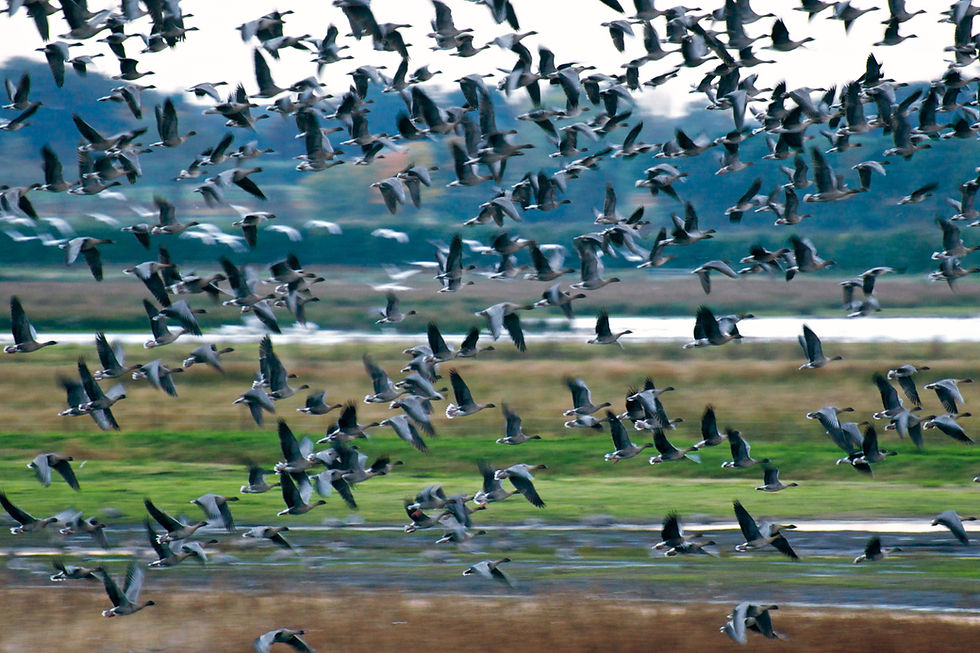
For me there is always a sense of great anticipation in the autumn months whilst I await news of the arrival of wintering birds. Perhaps it is a symptom of growing up watching wildlife on the Lancashire plains where there is great display of seasonality. Over the frosty months the North West provides a home for great numbers of migratory waterbirds. It has been a few weeks now since pink-footed geese (Anser brachyrhynchus) returned to our shores from their breeding grounds in Iceland and eastern Greenland but I never fail to get enthused by their arrival. Whilst out birdwatching in Aberlady Bay, Lothian, Scotland a few weekends ago, I stood in awe as a flock of 2,000 plus geese landed on the estuary.

For 57 years the Wildfowl & Wetlands Trust, in partnership with Joint Nature Conservation Committee and Scottish Natural Heritage, have conducted population monitoring of Icelandic breeding geese. In a huge co-ordinated effort of volunteers and staff, the numbers at wintering sites are counted across the UK and Iceland over weekends in October and November. In 2016 the estimated population of pink-footed geese was 481,341 with c98% wintering here in the UK (Mitchell and Brides 2017).
Over winter they are fairly well distributed across Scotland with sites in the North, East, Borders and the Central Belt with Aberdeenshire holding the largest concentrations. In England the main sites are in Norkfolk, and North West England with the greatest concentrations in Lancashire and Merseyside. Of course they can also be seen along their migration route in great skeins across the sky and at key staging sites.

Personally, I think seeing the large numbers of migrating geese is one of natures greatest spectacles and is the UK equivalent to the migrations seen on the great plains of Africa. It could be argued that it is even more dramatic given they have to cross a great expanse of open ocean along the way.
Of course there are not only pink footed geese to look out for as the UK is a regular haunt for a number of other migratory species including; barnacle geese (Branta leucopsis), brent geese (Both subspecies; Branta bernicla bernicla and B. b. hrota), taiga bean geese (Anser fabalis fabalis) , white-fronted geese (Both subspecies; Anser albifrons flavirostris and A. a. albifrons) and greylags (Anser anser, some migratory and some resident). There are also a few less regular visitors including snow geese blown off course. A full detailed account of pink-footed geese can be found on WWT's website
As well as grey geese we are also graced by another Icelandic species over the winter months, whooper swans (Cygnus cygnus). I can excitedly share the news that the first whooper swans have made their return to their favourite spots across the UK, including 21 arriving at WWT Martin Mere on the 4th of October.

Much like the Icelandic geese, whooper swans are monitored as part of an international monitoring programme across their wintering range in Britain, Ireland, Iceland and the Isle of Man. The most recent survey, the seventh international census, took place in January 2015. A record number of 34,004 swans were recorded, this was the highest count since surveys began (Hall et al., 2016). Their highest concentrations are in Cambridgeshire, Lancashire and Norfolk, where in 2015 6,513, 2,172 and 2,154 were counted respectively (Hall et al., 2016). Combined, England (c36%) and the Republic of Ireland (c35%) account for the majority (c70%) of the entire population (Hall et al., 2016).
As well as whooper swans the UK also hosts a significant proportion of the North Western European population of bewick's swans (Cygnus columbianus bewickii), a sub species of the tundra swan. This species has experienced significant declines in North West Europe in recent times and is therefore a conservation priority with its own International Single Species Action Plan. A full detailed account of whooper swans can be found on WWT's website.
There are some fantastic reserves to witness the great spectacles of geese and swans en masse. The Oa (RSPB Scotland), Loch Leven (RSPB Scotland), Martin Mere (WWT) and Caerlaverock (WWT) to name but a few. So with that in mind, find your nearest reserves, pick up your binoculars, camera, bird list or just go with yourself and go and enjoy one of natures great events at a wetland near you.
For regular posts and pics please follow my Facebook Page Doug Shapley Photography
Comments